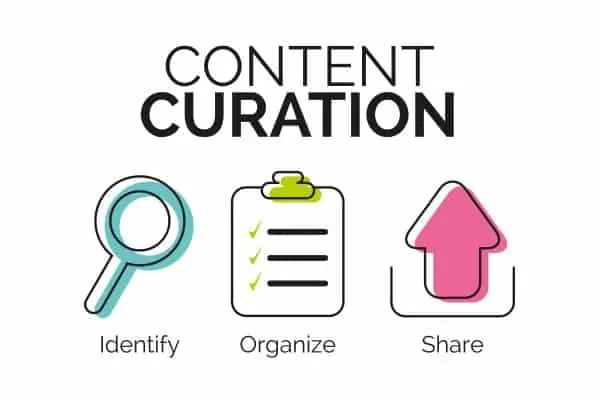
The process of selecting, gathering, compiling, and disseminating content from throughout the web is known as content curation.
Curated material frequently includes a list of excellent sources on a particular subject, such as “best of” lists or articles intended to teach a specific skill.
What Is Content Curation?
The act of reviewing, choosing, and sharing excellent material from outside sources on your website or social media sites is known as content curation.
Images, videos, statistics, infographics, quotable statements from professionals in the field, links to blog entries, and social media updates from other content creators are a few types of curated content.
To support the content they produce, brands use content curation. However, this does not imply that you should disclose any information you have. Instead, it would help to choose pieces or themes that will benefit you and your audience.
There are five types of content curation:
- Aggregation
The most common type of content curation allows companies to gather all relevant content about a topic in one place.
- Chronology
Brands present a curated timeline of events to trace the evolution of a specific trend.
- Mashups
Created and curated content come together to create a fresh and unique perspective on the topic.
- Distillation
Marketers highlight only the best insights about a trending topic. These usually come in the form of embedded tweets.
- Elevation
Curators synthesize relevant social posts and add their insight.
But while content curation should supplement your content creation strategy, it shouldn’t replace it. HootSuite recommends marketers share 60% curated content and 40% created ones. This strategy aims to offer additional resources and discussion points for your followers to engage in. There are many advantages to using this marketing approach.
Who Are the Content Curators?
![]()
You can find content curation everywhere. It could come in the form of a social media feed, an RSS feed, blog links, or an online news mashup like The Tilt’s news section in each newsletter.
In terms of content types, there are no restrictions. Any online digital content that may be shared, including songs, articles, videos, images, and articles, can be curated.
Without even realizing it, many of us have been engaging in content curation for years. Anyone who has a Facebook feed or Twitter stream is familiar with content curating. Social media’s most popular content curators typically have the most significant followings.
Why Should You Use Content Curation?
Cost- and time-saving
Forty-nine percent of business-to-business (B2B) marketers concur that content development causes their content marketing efforts to stall, according to a report by the Content Marketing Institute. Writing new pieces requires time, from research to publishing to interaction.
It also costs a lot of money for the 55 percent of marketers who employ their content generation staff. Contrarily, it is quick and easy to share articles and media.
Additionally, you get to maintain the volume of material you must provide while paying little to no money to be visible in your audience’s feed. You can use your content curation to create newsletters and emails.
Networking
Partnership marketing has served as a suitable model for many firms these last two years. It boosts not only a company’s market reach but also its revenue without taking on additional risk.
More businesses will use other people’s material in 2022 through commission-driven channels or B2B alliances.
A superb technique to provide outbound links that can affect your search engine optimization is content curation (SEO). When you credit a post of theirs that you’ve just shared, this could be a chance to get recognized by brands you want to network with.
And although while you shouldn’t anticipate receiving a backlink in return, this may nevertheless start a discussion that could result in a collaboration.
Authority Building
One of the most recent changes in the marketing sector is the shift in emphasis from brand recognition and product caliber to customer needs.
More companies aspire to establish themselves as thought leaders or authoritative voices in their field. One of the main forces behind SEO, authority almost always results in a first-page listing.
By offering sector-specific insights through content curation, you can position your business as a reliable source of pertinent information. It conveys to people that you know about issues they find important, enhancing your credibility in your industry.
This is a crucial time to hold this position since the content arms race is louder than ever.
What Constitutes a Successful Content Curation Strategy?
Your audiences must find the content you curate to be relevant and helpful. Curating cat memes is entertaining, but if your audience includes horse owners, cat memes won’t truly resonate with them. This kind of content is unrelated.
Sooner or later, they will stop paying attention to you, your content will become less attractive, and the algorithms will change how they provide range accordingly.
As with any information you intend to publish, the content you curate must be current and educational. Additionally, you shouldn’t just link to other people’s stuff. To explain why you are sharing it, you must provide context.
Suppose you’re producing material for an email newsletter, for instance. In that case, you can include one or two sentences in the introduction explaining why you had a particular link or why readers should click on it.
Social media operates similarly. When selecting and distributing, please describe why the content is essential and what drew your interest.
To explain why use 140 characters or the caption space. This allows you to express your opinion about the information, whether you agree with it or not.
Three popular strategies for content curation
Many companies create an online magazine for their brands by gathering excellent information on exciting themes that customers will be interested in, organizing it, and then sharing it with readers.
Making your website a “one-stop” resource for the most fantastic information about your goods and services will prevent customers from looking up relevant topics elsewhere.
- “Best of” aggregator blog posts – Some brands compile content over a predetermined period and release them on a specific day of the week or month. As a result, its viewers expect that it will deliver the best material at regular intervals and in an easily digestible style. One illustration is Hootsuite’s weekly post titled “This Week in Social,” where they discuss the most recent developments in social media in terms of trends, announcements, and features.
- Email newsletters- Because it allows for direct consumer communication, email is another excellent route for content curators. By delivering high-quality material straight to them, you can eliminate the need for people to hunt for it. Many email marketing platforms, including AWeber, allow you to do A/B tests on headlines to determine which ones generate the most interest.
- Sharing on social media- On social media, sharing insightful content from other thought leaders in your sector can significantly impact you. It conveys assurance and knowledge to your followers, letting them know you are knowledgeable about your industry and value their input.
What Are Some Advice for Curating Content?
- Although content curating may appear to be a free-for-all of information, a content curator must follow essential guidelines to be effective. Lack of attribution or lack of a source link, automated curation or content aggregation, which can result in subpar curating, and emphasizing quantity over quality are all factors that can make content curation fail.
- Relying solely on content curation rather than combining this marketing strategy with content creation might also be risky. The Tilt advises combining collected and original material for the best results when employing content curation to boost SEO.
Advantages of content curation for SEO

By obtaining inbound links from other powerful websites, content curation can also benefit your search engine optimization efforts. Preciprocation is a term that has been used to describe this process. Start by compiling a list of reputable, well-known websites that have demonstrated a willingness to link to further resources through blog posts, news roundups, or “how-to” guides.
Ensure they are informed once you share their articles on your social media and email marketing channels. It would help if you communicated with them via email or blog comments. Make sure your interactions with them show that you genuinely value their work by posing insightful questions and offering insightful remarks.
When you write about a related subject, mention them in your piece. Then, after you’ve shared it with your followers, ask your link prospect if they’d be willing to share it with their followers.
Do not anticipate receiving something in exchange. Although your business has promoted their work, they are not required to reciprocate. But when you take the time to build a proper relationship with your prospect, your chances of being shared and connected to you are much higher.
All parties benefit from content curation. It helps the publisher whose work you are sharing. It benefits your users by saving them time by removing the need for them to search for valuable content, and it helps you retain your customers and allow them to continue to enjoy your brand. You can come up with fresh concepts for your content strategy while gaining the respect of your industry colleagues by curating material.
Conclusion
For social media, especially Twitter and Facebook, curating content is a good idea. Of course, Pinterest is all about curation. As time goes on, you can incorporate content curation into your email newsletters and website content.
Always make sure that the content you collect and post is utterly relevant to the audiences you are trying to reach.
Good luck to you!

Pingback: The Content Curation Strategies You Need To Know in 2024 - Eboxman - Dropship Success Tips